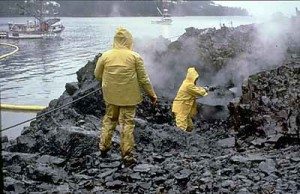 By Alanna Brown, LuxEco Editorial Assistant
By Alanna Brown, LuxEco Editorial Assistant
The powers-that-be have refused the natural solutions being publicly offered by nation-wide volunteers for cleanup of the BP oil disaster. Instead, they have chosen to dump chemical dispersants on the spill site; namely, Corexit. Talk about adding insult to injury. With several urgent prompts being made by eco-concerned citizens, it seems BP’s decided approach—for now, anyway—is to further pollute the already distressed Gulf.
We first learned about Corexit in 1989, when Nalco engineered it for cleanup of the Exxon Valdez oil spill in Prince William Sound. In this video, while workers claim the use of Corexit to be a success, one can’t help but notice the biohazard suits and masks they wear to avoid contact with it. So basically, what we have now, in 2010, being dumped into our Gulf by the tens of thousands of gallons is a chemical not to be touched or inhaled. According to the Alaska Community Action on Toxics, the use of Corexit during the Exxon Valdez oil spill caused “respiratory, nervous system, liver, kidney and blood disorders” in people.
So what exactly are the safety warnings and environmental precautions of this chemical? And furthermore, what is it made of? To be precise, BPs’ efforts have released 800,000 gallons of Corexit into the ocean, consisting of two types that were approved for use by the Environmental Protection Agency. They are Corexit 9500 and Corexit(R) EC9527A. Here is a look at a chart from the EPA’s technical product bulletin on the latter:
X. ANALYSIS FOR HEAVY METALS, CYANIDE, AND CHLORINATED HYDROCARBONS
| Compound | Concentration (ppm) |
| Arsenic | < 0.005 |
| Cadmium | < 0.01 |
| Chromium | < 1.0 |
| Copper | < 0.2 |
| Lead | < 0.1 |
| Mercury | < 0.003 |
| Nickel | < 0.1 |
| Zinc | 0.1 |
| Cyanide | < 0.01 |
| Chlorinated Hydrocarbons | < 0.01 |
This means that the one-thousandth percent concentration of arsenic, the one-tenth percent concentration of lead, the one-hundredth percent concentration of cyanide, and all the other deadly compounds listed, have been dumped into our sea 800,000 times over. The Nalco safety data sheet on Corexit 9500 gives many warnings about the product, stating in the Emergency Overview, “Do not get in eyes, on skin, on clothing. Do not take internally. Avoid breathing vapor. Use with adequate ventilation. In case of contact with eyes, rinse immediately with plenty of water and seek medical advice. After contact with skin, wash immediately with plenty of soap and water.” It goes on to give detailed first aid measures if any of these warnings are not properly observed. However, the most haunting of all is one simple statement under the Environmental Precautions heading. It reads plainly, “Do not contaminate surface water.”
It is far too late to heed that warning. Now, twenty thousand gallons of Corexit 9500 are being used in the Gulf every day. Environmentalists worry that Corexit will not only do immediate harm to workers, but that it will affect fish and shellfish in the Gulf, and inevitably enter the human food chain.
One source calls this whole thing a large-scale experiment; using dispersants at this volume and depth beneath the ocean surface has never been done, and we are virtually ignorant as to the outcome. A research team headed by David Hollander, a University of South Florida oceanographer, discovered a 6-mile wide “oil cloud” submerged at visibly undetectable depths under the ocean surface. The giant plume of dissolved hydrocarbons was the second found since the April 20 catastrophe. They are a particularly insidious threat because of their scant visibility; they float in what appears to be normal seawater. In regard to the cause of these clouds, Hollander said, “It may be due to the application of the dispersants that a portion of the petroleum has extracted itself away from the crude and is now incorporated into the waters with solvents and detergents.”
Another article raising public awareness on the issue cites toxicology expert Dr. William Sawyer. In a statement he made to the Gulf Oil Disaster Recovery Group, he presented a worst-case analysis of the risks associated with Corexit. Sawyer claims that Corexit is known as deodorized kerosene, “a substance with health risks to humans as well as sea turtles, dolphins, breathing reptiles, birds, and any species that need to surface for air exchanges.” The article also discusses why these dispersants bare the name. It is because, simply, the chemicals cause the oil to form globules and then those globules disperse via wind and wave action. “So instead of having the oil collect at the surface, dispersed droplets of oil can spread more quickly and in more directions. This means the droplets linger longer in the water, collecting on the seabed and harming the ecosystem offshore.” This adding of unnatural chemicals and rendering of a three-dimensional dispersion ultimately raises the toxicity level by about 10 times.
Naturally, the next issue of concern is the affect Corexit has had so far on human life. A CBS news clip informs us that cleanup workers with exposure to dispersants on the Deepwater Horizon spill have already fallen ill. On May 7, 7 workers were rushed to the Jefferson Parish emergency room and as of June 7, there were already 75 people complaining of flu-like respiratory symptoms. They attribute this to the fact that many workers wore little to no protective gear when the cleanup first began. Workers who have since worn the proper gear have not reported illness. However, the number of injured is predicted to increase.
This leads to yet another serious inquisition regarding the use of Corexit: how will the injured receive accurate medical care when 10-30% of the compounds that structure the chemical are unknown? By reviewing the previously mentioned manufacturer’s safety data sheet, we find the main components to be 2-butoxyethanol, organic sulfonic acid, and a small amount of propylene glycol. However Nalco will not release that crucial 10-30% of its proprietary makeup due to unwanted industry competition. Despite this, Wired Science briefs us on just one such competitor: Dispersit. This dispersant was approved 10 years ago by the EPA, and is being touted as “twice as good at breaking down South Louisiana crude oil in lab comparisons…[and] half as toxic.”
Most would agree, the powers-that-be don’t have the best interest of our eco-system at heart. But they can’t turn off our voices; those of us who care have the ability to speak out on behalf of the environment. There are ways you can help.













